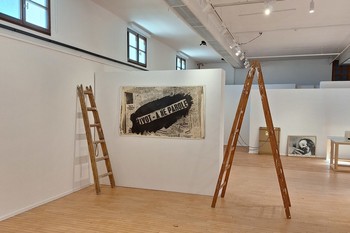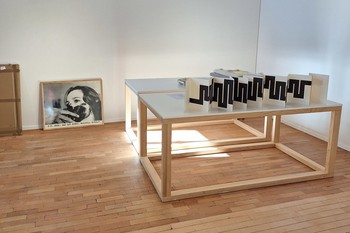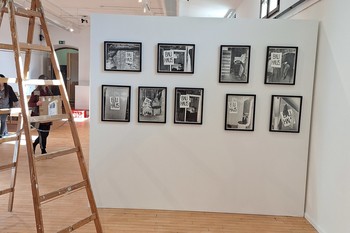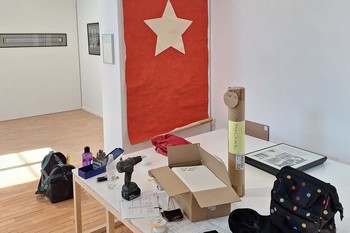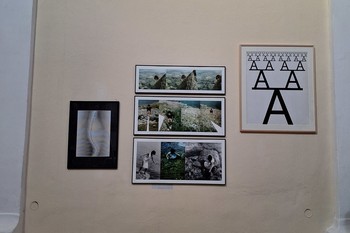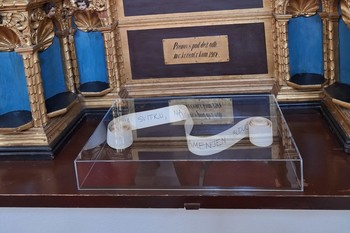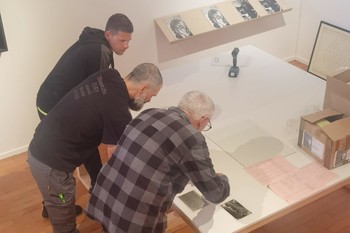For the Democratisation of Art – Revisited
Radical Artistic Practices in Yugoslavia (1960–1990)
26 Nov 2025 – 17 May 2026
Castle Gallery, Castle Chapel
Curators: Barbara Borčić, Darko Šimičić
Artists: Marina Abramović, Branko Balić, Boris Cvjetanović, Vlasta Delimar, Braco Dimitrijević, Dubravka Đurić, Gorgona, Tomislav Gotovac, Group KÔD, Group of Six Artists, Zlatko Hajdler, Matjaž Hanžek, Sanja Iveković, Željko Jerman, Julije Knifer, Ivan Kožarić, Katalin Ladik, Laibach Kunst, Miroslav Mandić, Mangelos (Dimitrije Bašičević), Vlado Martek, Milenko Matanović, Slavko Matković, Marijan Molnar, David Nez, OHO, I. G. Plamen, Marko Pogačnik, Bogdanka Poznanović, Mirko Radojičić, Rajko Radovanović, Vladan Radovanović, Red Peristyle, Nejč Slapar, France Pibernik, Đuro Seder, Mladen Stilinović, Sven Stilinović, Josip Stošić, Bálint Szombathy, Judita Šalgo, Miško Šuvaković, Raša Todosijević, Slaven Tolj, Marija Grazio Tolj, Goran Trbuljak, Josip Vaništa
The curation of the exhibition is based on the collection of Darko Šimičić, focusing on the works of artists from the former Yugoslavia between 1960 and 1990. It is on view in several areas of Škofja Loka Museum – at the Castle Gallery, the castle chapel and the entrance hall. The concept of the exhibition is not chronological, it opens up the possibility of dialogue between the works, ideas and artistic practices. The exhibited works are presented in five (intertwined) sections: Noart · Life, Not Slogans · Individual – Group · Paysage · Painted Word.
This is neither a thematic exhibition, nor is it a presentation of a private collection. And yet it is both at the same time. And more. It introduces viewers to the New Artistic Practice of the featured artists – painters, poets, photographers, filmmakers and performers – who experimented in all traditional artistic disciplines, while also staying open to new media forms of artistic creation. When it came to their work, they emphasised fundamental ethical stances as opposed to the visual aesthetics of modernism; to them, ethics became more important than aesthetics.
They showcased their work not only in galleries, but also through various actions in public spaces, in squares and streets – in the space between art and life. In addition, the exhibition presents the artists’ self-organisation and the creation of grassroots cultural venues, as well as a host of partnerships and collaborations that were set up in the federative state of Yugoslavia by artists themselves and by various organisations, in particular the network of student cultural centres.
The aim of the exhibition and the accompanying events is to present, at least fragmentarily, the flourishing art scene and New Artistic Practice in various towns and cities that were part of Yugoslavia at the time, from Belgrade, Ljubljana and Zagreb to Novi Sad, Kranj, Škofja Loka, Split, Subotica and Dubrovnik. In doing so, it establishes a dialogue with the conceptual heritage of groups and artists, aimed at the democratisation of art, while also striving to show that art is not merely a reflection of the world, but also raises social issues and creates space for dialogue and cooperation.
The exhibition is titled after the works and public actions of Marijan Molnar from 1979, when he called on citizens/audiences to sign a petition “for the democratisation of art”. He was pictured in newspapers under this slogan wearing a balaclava, he graffitied it on walls and he put up banners with it on the façade of buildings. We believe that this slogan, straightforward and resolute as it is, does a good job at illustrating the artistic atmosphere of that time.
Acknowledgements: Boris Cvjetanović, Dubravka Đurić, Sarah Gotovac / Inštitut Tomislav Gotovac, Marijan Molnar, Diana Nenadić / Hrvaška filmska zveza, Darko Šimičić and Ksenija Šoštar, Nika Šimičić, Slaven Tolj
